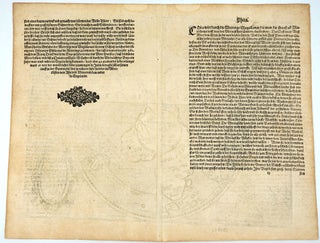Chica Sive Patagonia et Australis Terra.
Cologne: 1598. Extremely rare and early map of the Southern Hemisphere that attempts to define the assumed Great South land mass, including today's Australia, Antarctica, Indonesia, South Africa & Argentina. The top of the map has an interesting Mercator projection of Patagonia achingly close to a large land mass "Terrae Australis Pars". C. Della Victoria and the illustration of Magellan's ship the Victoria bears witness to his discovery of the strait that now bears his name. Below is a polar projection of a great south land entitled "Terra Australis". Within the Antarctic Circle, termed "Terra Incognitia" is an array of mountains and 3 large named rivers. Part of the coast (actually the north coast of Australia) is marked with Marco Polo's kingdoms of Beach, Lucach and Maletur. This is a German re-engraving of the Wytfliet Map dated 1597 (Spence 3010), but is much rare than it (see discussion below). German text on the verso with the header "Chica" above one page. The Quad map of a year later (Spence 3011) included the addition of "Fretum Magellanicum" at the Straights. (see Tooley plt 102). Oddly, the Metellus is not in Spence, but should be between 3010 and 3011. See Schilder fig. 6 for the Wyfliet map. Copper engraving, 22 x 28.5 cms.
"Wytfliet and Metellus produced the first separate printed maps of the Southern Hemisphere. Both are foundation maps of America and Australia. The Wytfliet is known to have been produced in 1597, the Metellus, which is much rarer and seldom available on the market, is usually dated 1598 but some scholars have argued the possibility that it may precede the Wytfliet. The Metellus is acknowledged as, by far, the finer engraving of the two, which, along with its rarity and importance, makes it a focal point of any collection of early American and Australian maps." (After Casten). "As with the Cornelis Wytfliet a year earlier this publication contained a set of maps relating to the Americas only. All but one are derived from the Wytfliet. These were used to illustrate the German edition of José de Acosta's 'De Natura Nova Orbis', first published in Salamanca, 1588. Acosta was a Spanish Jesuit missionary, historian and cosmographer. The maps, however, are attributed to Johannes Matalius Metellus (Jean Matal in his native French), a very well respected geographer of his day. In the 'America sive Novus Orbis' of 1600, he is named as the cartographer of the maps but, most probably, did not see their completion as he died in 1597. The work was finished by a friend, Meurer identifies him as Conrad Loew, a pseudonym for Matthias Quad. Born in Burgundy, 1520, Metellus spent much of his working life in Louvain where, of course, the Wytfliet atlas was published. However, he spent his last years in Cologne, dying in 1597. This leads us to the possibility thet the Metellus actually pre-dates the Wytfliet as the first atlas concentrating on America. A number of questions are posed. Is there an earlier edition still unknown, as all issues are extremely rare ? Is Metellus the true author of the Wytfliet maps? All issues have text on the back, and are extremely rare." (Burden on the Conibas map) Only a handful examples of the Metellus books are known, see Burden 115 for a list of locations. Item #17319
Price: $3,500.00



